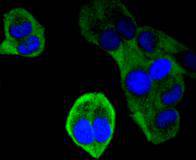Product Name :
Ubiquitin D polyclonal antibody Background :
FAT10, also designated Ubiquitin D or Diubiquitin, is a 165 amino acid protein encoded in the major histocompatibility complex (MHC) that consists of two domains which share significant homology with ubiquitin. Each domain contains two cysteines, along with a free C-terminal diglycine motif required for FAT10 conjugate formation. FAT10 is inducible by interferon-g and tumor necrosis factor a (TNF?). The FAT10 protein interacts with MAD2, a component of the spindle checkpoint, and plays a role in antigen presentation, cytokine response, apoptosis and mitosis. It may also regulate cell growth during dendritic cell or B cell activation and development. FAT10 mRNA is expressed mainly in some dendritic cells and lymphoblastoid lines and in other specific cells subsequent to interferon-g induction. The human FAT10 gene, designated UBD, maps to chromosome 6p21.3 and is overexpressed in the tumors of various epithelial cancers. Product :
Rabbit IgG, 1mg/ml in PBS with 0.02% sodium azide, 50% glycerol, pH7.2 Storage&Stability :
Store at +4°C after thawing. Aliquot store at -20°C or -80°C. Avoid repeated freeze / thaw cycles. Specificity :
Ubiquitin D polyclonal antibody detects endogenous levels of Ubiquitin D protein. Immunogen :
recombinant protein Conjugate :
Unconjugated Modification :
Unmodification
Ubiquitin D polyclonal antibody Background :
FAT10, also designated Ubiquitin D or Diubiquitin, is a 165 amino acid protein encoded in the major histocompatibility complex (MHC) that consists of two domains which share significant homology with ubiquitin. Each domain contains two cysteines, along with a free C-terminal diglycine motif required for FAT10 conjugate formation. FAT10 is inducible by interferon-g and tumor necrosis factor a (TNF?). The FAT10 protein interacts with MAD2, a component of the spindle checkpoint, and plays a role in antigen presentation, cytokine response, apoptosis and mitosis. It may also regulate cell growth during dendritic cell or B cell activation and development. FAT10 mRNA is expressed mainly in some dendritic cells and lymphoblastoid lines and in other specific cells subsequent to interferon-g induction. The human FAT10 gene, designated UBD, maps to chromosome 6p21.3 and is overexpressed in the tumors of various epithelial cancers. Product :
Rabbit IgG, 1mg/ml in PBS with 0.02% sodium azide, 50% glycerol, pH7.2 Storage&Stability :
Store at +4°C after thawing. Aliquot store at -20°C or -80°C. Avoid repeated freeze / thaw cycles. Specificity :
Ubiquitin D polyclonal antibody detects endogenous levels of Ubiquitin D protein. Immunogen :
recombinant protein Conjugate :
Unconjugated Modification :
Unmodification
-
 Western blot analysis of Ubiquitin D on Hela cells lysates using anti-Ubiquitin D antibody at 1/1,000 dilution.
Western blot analysis of Ubiquitin D on Hela cells lysates using anti-Ubiquitin D antibody at 1/1,000 dilution. -
 ICC staining Ubiquitin D in Hela cells (green). The nuclear counter stain is DAPI (blue). Cells were fixed in paraformaldehyde, permeabilised with 0.25% Triton X100/PBS.
ICC staining Ubiquitin D in Hela cells (green). The nuclear counter stain is DAPI (blue). Cells were fixed in paraformaldehyde, permeabilised with 0.25% Triton X100/PBS.
Bioworld Biotech only provide peptides for our antibodies and do not provide additional peptide customization services.
Price/Size :
USD 368/1mg/vial
Tips:
For phospho antibody, we provide phospho peptide(0.5mg) and non-phospho peptide(0.5mg).Describe :
Blocking peptides are peptides that bind specifically to the target antibody and block antibody binding. These peptide usually contains the epitope recognized by the antibody. Antibodies bound to the blocking peptide no longer bind to the epitope on the target protein. This mechanism is useful when non-specific binding is an issue, for example, in Western blotting (WB) and Immunohistochemistry (IHC). By comparing the staining from the blocked antibody versus the antibody alone, one can see which staining is specific; Specific binding will be absent from the western blot or IHC performed with the neutralized antibody.Formula:
Synthetic peptide was lyophilized with 100% acetonitrile and is supplied as a powder. Reconstitute with 0.1 ml DI water for a final concentration of 10 mg/ml.The purity is >90%,tested by HPLC and MS.
Storage:
The freeze-dried powder is more stable. For short time at 2-8°C. For long term storage store at -20°C.
Note :
This product is for research use only (RUO only). Not for use in diagnostic or therapeutic procedures.
 Ubiquitin D polyclonal antibody
Ubiquitin D polyclonal antibody  Datasheet
Datasheet COA
COA MSDS
MSDS SHIP
SHIP